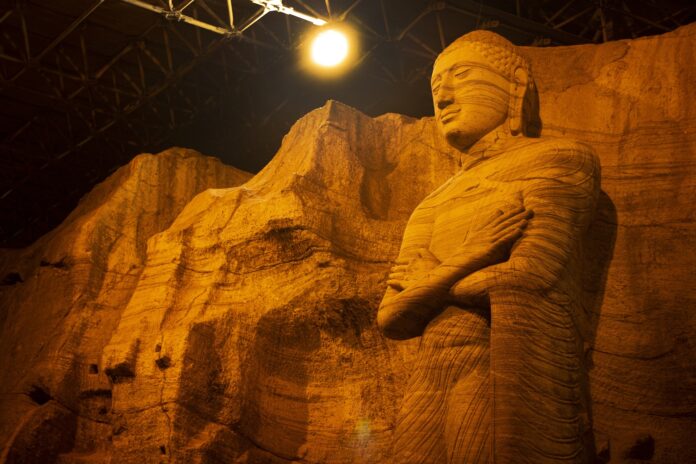If you’re looking for a place to delve into the rich history of Sri Lanka, Polonnaruwa is a must-visit destination. This ancient city served as the capital of Sri Lanka during the 11th and 12th centuries, and it’s filled with fascinating ruins that will take you back in time.
History of Polonnaruwa Kingdom
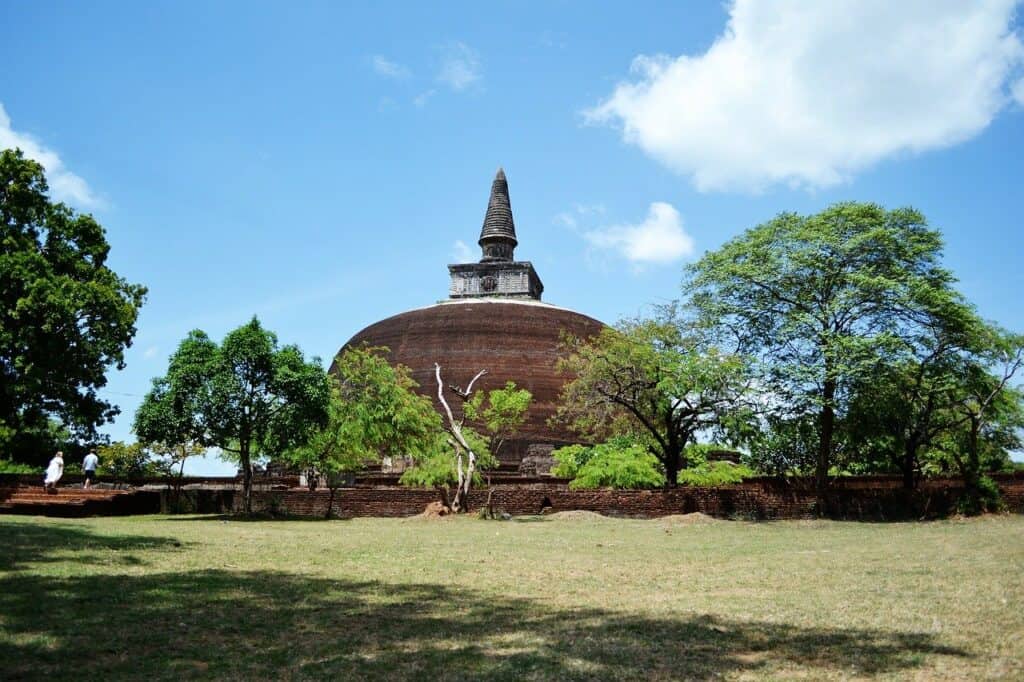
The history of the Polonnaruwa Kingdom is both rich and complex. The kingdom was established in the 11th century, following a period of turmoil and instability in Sri Lanka. The Anuradhapura Kingdom, which had been the center of power and culture in Sri Lanka for over a thousand years, had declined due to invasions by the Cholas and internal power struggles.
In 1017, King Vijayabahu I emerged as a powerful leader and established the Polonnaruwa Kingdom. He defeated the Cholas and reunited the country under his rule. However, his reign was short-lived, and he was succeeded by a series of weak and ineffective rulers.
It was not until the reign of King Parakramabahu I that the Polonnaruwa Kingdom truly flourished. He was a visionary leader who believed in the power of culture and art to bring people together. He built many important structures, including the Royal Palace, Rankoth Vehera, Kiri Vehera, Polonnaruwa Vatadage, and Parakrama Samudraya.
King Parakramabahu was not only a patron of the arts but also a skilled warrior. He fought many successful battles and expanded the kingdom’s territory. He also built an advanced irrigation system that allowed for agriculture to flourish, which in turn helped to boost the kingdom’s economy.
Under King Parakramabahu’s reign, Polonnaruwa became a center of culture, religion, and trade. The city attracted merchants from all over the world, who brought with them a diverse array of goods and ideas. The kingdom also became known for its advanced education system, which produced many scholars and artists.
However, the Polonnaruwa Kingdom faced many challenges, both external and internal. In the 13th century, the Pandyas, a powerful dynasty from South India, invaded Sri Lanka and captured Polonnaruwa. The city was sacked, and many of its treasures were lost or destroyed.
After the Pandyas were driven out, the Polonnaruwa Kingdom continued to decline due to internal power struggles. The city was eventually abandoned and forgotten until it was rediscovered by British archaeologists in the 19th century.
Today, the ruins of Polonnaruwa stand as a testament to the kingdom’s rich history and cultural heritage. Visitors from all over the world come to explore the ancient city and marvel at its impressive structures and intricate carvings. The Polonnaruwa Kingdom may have fallen, but its legacy lives on.
King Parakramabahu
King Parakramabahu I is regarded as one of the most significant and influential rulers in Sri Lankan history. He was a visionary leader who brought about a golden age of culture and prosperity in the Polonnaruwa Kingdom.
Born in 1123, Parakramabahu was the son of King Vijayabahu I. He grew up in a time of political and social unrest, with the Polonnaruwa Kingdom struggling to maintain its power against external threats and internal conflict.
Parakramabahu became king in 1153, at the age of 30. He immediately set about implementing his vision for the kingdom, which was to make it a center of culture, religion, and trade.
One of Parakramabahu’s greatest achievements was his irrigation system, which was one of the most advanced in the ancient world. He built massive tanks and canals that allowed for the cultivation of vast amounts of land. This in turn boosted the kingdom’s economy and made it one of the wealthiest in the region.
Parakramabahu was also a patron of the arts and culture. He built many important structures, including the Royal Palace, Rankoth Vehera, Kiri Vehera, Polonnaruwa Vatadage, and Parakrama Samudraya. These structures were not only impressive in their scale and design but also served important religious and cultural functions.
Parakramabahu was a devout Buddhist and worked to promote Buddhism throughout the kingdom. He commissioned many statues and carvings, including the famous Gal Vihara, which features four massive Buddha statues carved into a granite rock face.
Despite his many achievements, Parakramabahu was not without his faults. He was a strict ruler who demanded loyalty and obedience from his subjects. He also engaged in many military campaigns, some of which were brutal and led to significant loss of life.
Parakramabahu died in 1186, at the age of 63. His legacy lives on, however, as one of the most important and influential figures in Sri Lankan history. Today, visitors to the Polonnaruwa Kingdom can see the many structures and works of art that he commissioned and can marvel at the scale and complexity of his irrigation system.
Ruins of the Royal Palace of King Parakramabahu
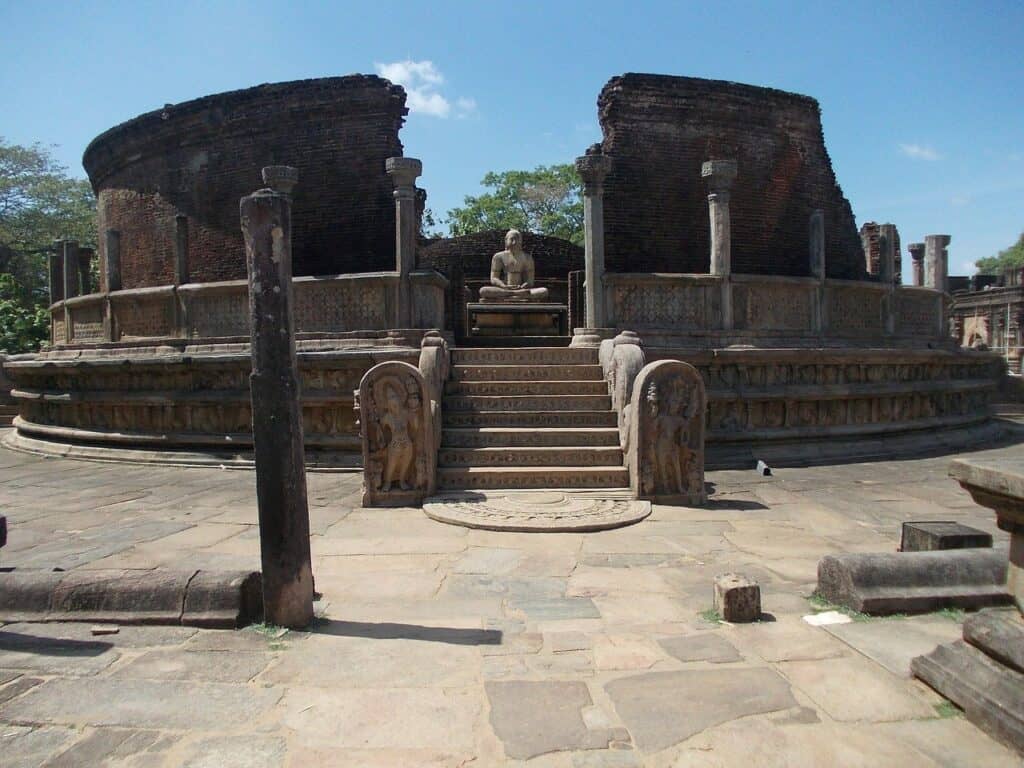
One of the most impressive structures in Polonnaruwa is the ruins of the Royal Palace of King Parakramabahu. While it’s not much more than a series of walls now, it’s easy to imagine the grandeur of the palace during its heyday.
Rankoth Vehera
Rankoth Vehera is one of the most iconic and important structures in the ancient city of Polonnaruwa. This stupa, which is located in the Sacred Quadrangle, is believed to have been built during the reign of King Nissanka Malla, who ruled from 1187 to 1196 AD.
The stupa is 55 meters high and is one of the tallest structures in Polonnaruwa. It is also one of the most impressive in terms of its design and construction. The dome of the stupa is made of brick, while the base and upper parts are made of stone. The entire structure is adorned with intricate carvings and sculptures, including depictions of gods and goddesses, animals, and mythical creatures.
The stupa is surrounded by a large courtyard, which is paved with granite slabs. The courtyard is enclosed by a low wall, which is decorated with sculptures of elephants, lions, and other animals.
One of the most interesting features of Rankoth Vehera is its relic chamber. This chamber is located in the center of the stupa and is believed to contain relics of the Buddha. The chamber is accessible via a narrow stairway, which leads up to a small platform at the top of the stupa. From here, visitors can enjoy panoramic views of the surrounding area.
In addition to its religious significance, Rankoth Vehera also played an important role in the political and social life of the Polonnaruwa Kingdom. It was often used as a gathering place for important religious and cultural events, as well as for meetings of the king and his advisors.
Today, Rankoth Vehera remains one of the most important and iconic structures in Polonnaruwa. It is a popular destination for tourists, who come to marvel at its beauty and learn about its rich history and cultural significance. Whether you are a history buff or simply a lover of beautiful architecture and art, Rankoth Vehera is definitely worth a visit.
Kiri Vehera
Kiri Vehera is one of the most significant Buddhist stupas in the ancient city of Polonnaruwa. It is located in the Sacred Quadrangle and is believed to have been built during the reign of King Parakramabahu the Great, who ruled from 1153 to 1186 AD.
The stupa is relatively small compared to other structures in Polonnaruwa, but it is nevertheless a marvel of engineering and design. It is 30 meters high and is built entirely of brick. The dome of the stupa is surrounded by a stone fence, which is adorned with beautifully carved figures of elephants, lions, and other animals.
One of the most unique features of Kiri Vehera is its name, which means “milk-white stupa” in Sinhalese. This name was given to the stupa because it was originally covered in a layer of white plaster, which gave it a distinctive appearance. Although the plaster has since been removed, the name has endured.
Like other stupas in Polonnaruwa, Kiri Vehera is believed to contain relics of the Buddha. According to legend, the relics were brought to Sri Lanka by the missionary monk Mahinda, who was sent to the island by the Indian emperor Ashoka in the 3rd century BC. The relics are said to be enshrined in a chamber at the center of the stupa.
Today, Kiri Vehera is an important pilgrimage site for Buddhists from all over the world. It is also a popular destination for tourists, who come to admire its beauty and learn about its rich history and cultural significance. Whether you are a devout Buddhist or simply a lover of beautiful architecture and art, Kiri Vehera is definitely worth a visit.
Polonnaruwa Vatadage
The Polonnaruwa Vatadage is a circular relic house that is believed to have been built during the 12th century, in the ancient city of Polonnaruwa. It is located in the Sacred Quadrangle, in close proximity to the Atadage and Hatadage structures.
The Polonnaruwa Vatadage is considered one of the most significant structures in the ancient city, due to its historical and religious importance. It was built to house the relics of the Buddha, which were believed to have been brought to Sri Lanka by the missionary monk Mahinda, in the 3rd century BC.
The Vatadage is built in a circular shape, with four entrances facing each of the cardinal directions. The structure is made of stone and is adorned with intricate carvings and sculptures, including depictions of elephants, lions, and other animals, as well as intricate floral designs.
At the center of the Vatadage is a small platform that is believed to have once held a statue of the Buddha. Surrounding the platform are four stone pillars, which are believed to have supported a wooden roof. The roof is long gone, but the pillars and the platform remain, offering a glimpse into the structure’s original design.
One of the most unique features of the Polonnaruwa Vatadage is its moonstones. Moonstones are ornamental stones that are often found at the entrance of Buddhist temples in Sri Lanka. The moonstone at the entrance to the Polonnaruwa Vatadage is particularly intricate, with multiple rings of carvings that depict different aspects of Buddhist cosmology.
Today, the Polonnaruwa Vatadage remains an important pilgrimage site for Buddhists from all over the world. It is also a popular destination for tourists, who come to admire its beauty and learn about its rich history and cultural significance. Whether you are a devout Buddhist or simply a lover of beautiful architecture and art, the Polonnaruwa Vatadage is definitely worth a visit.
Nissanka Latha Mandapaya
The Nissanka Latha Mandapaya is a unique structure located within the ancient city of Polonnaruwa, Sri Lanka. It was built during the reign of King Nissanka Malla, who ruled the kingdom from 1187 to 1196. The structure is believed to have been used for various purposes, including as an audience hall for the king and as a place for religious ceremonies.
The Nissanka Latha Mandapaya is a rectangular building that is situated on a raised platform. It is believed that the structure was once used as a pavilion for the king, as it overlooks the beautiful Parakrama Samudraya reservoir. The pavilion is supported by 40 intricately carved stone columns, which add to the structure’s grandeur and elegance.
One of the most notable features of the Nissanka Latha Mandapaya is its elaborate carvings. The entire structure is adorned with intricate stone carvings, including depictions of lions, elephants, and other animals, as well as beautiful floral motifs. The carvings are so intricate and delicate that they are considered some of the finest examples of medieval Sinhalese stone carvings.
The Nissanka Latha Mandapaya is also home to a number of beautiful moonstones, which are ornamental stones that are often found at the entrance of Buddhist temples in Sri Lanka. The moonstones at the entrance to the Nissanka Latha Mandapaya are particularly beautiful, with multiple rings of carvings that depict different aspects of Buddhist cosmology.
Today, the Nissanka Latha Mandapaya is a popular tourist attraction and a testament to the rich cultural heritage of Sri Lanka. Visitors to the ancient city of Polonnaruwa should definitely make a point of visiting this beautiful and historic structure, which is sure to leave a lasting impression.
Sandakada Pahana
The Sandakada Pahana is a unique stone carving that is found in Sri Lankan architecture, particularly in the ancient city of Polonnaruwa. It is a semicircular shaped carving that is often found at the entrance of Buddhist temples, symbolizing the Buddhist concept of the cycle of rebirth.
The Sandakada Pahana is also known as the Moonstone due to its circular shape, which resembles the phases of the moon. It is typically made of granite or limestone and features intricate carvings that symbolize the cycle of life and death. The carving is divided into four concentric rings, with each ring depicting a different aspect of Buddhist cosmology.
The outermost ring typically features images of animals, including elephants, horses, lions, and bulls. These animals are believed to represent the stages of birth, old age, sickness, and death. The second ring depicts a scrolling floral pattern that is meant to symbolize the cycle of life and growth. The third ring often features the lotus flower, which is a symbol of purity and enlightenment in Buddhism. Finally, the innermost ring features a flame-like pattern that symbolizes the final stage of enlightenment.
The Sandakada Pahana is a beautiful and meaningful symbol of Buddhist philosophy and is an important part of Sri Lankan cultural heritage. Visitors to Polonnaruwa should definitely take the time to explore the ancient city’s temples and see the exquisite stone carvings for themselves. The Sandakada Pahana, with its intricate symbolism and beautiful design, is truly a masterpiece of ancient Sri Lankan art.
Polonnaruwa Parakrama Samudraya
Parakrama Samudraya, also known as the Sea of Parakrama, is a massive man-made reservoir located in the ancient city of Polonnaruwa, Sri Lanka. The reservoir was built by King Parakramabahu I, who ruled the kingdom from 1153 to 1186. It is one of the largest ancient irrigation systems in Sri Lanka and was built to provide irrigation water to the vast agricultural lands in the area.
The Parakrama Samudraya covers an area of 26 square kilometers and has a capacity of 134 million cubic meters of water. It is fed by several tributaries and channels, which collect water from the surrounding hills and transport it to the reservoir. The reservoir was built with a massive earthen dam, which is nearly 14 kilometers long and 14 meters high.
In addition to its practical purposes, the Parakrama Samudraya also played an important role in the religious and cultural life of the ancient city. The reservoir is surrounded by several ancient temples and monuments, including the Nissanka Latha Mandapaya, which is believed to have been used by King Nissanka Malla for religious ceremonies.
Today, the Parakrama Samudraya remains an important source of irrigation water for the agricultural lands in the area. It is also a popular tourist attraction, offering visitors the opportunity to see the impressive engineering feats of the ancient Sri Lankan civilization. Visitors can explore the surrounding temples and monuments or simply relax and enjoy the stunning natural beauty of the area. The Parakrama Samudraya is a testament to the ingenuity and skill of the ancient Sri Lankan people and is a must-see destination for anyone visiting the ancient city of Polonnaruwa.
Getting to Polonnaruwa
Polonnaruwa is located in the north-central province of Sri Lanka, about 215 km from Colombo. The easiest way to get there is by taking a train or bus from Colombo to the nearby city of Habarana and then taking a tuk-tuk or taxi to Polonnaruwa.
Best Time to Visit Polonnaruwa
The best time to visit Polonnaruwa is during the dry season, which runs from May to September. This is when you’ll have the best chance of sunny days and clear skies, making it easier to explore the ancient ruins. However, if you don’t mind a little rain, you can still visit Polonnaruwa during the other months of the year.
Things to do in Polonnaruwa
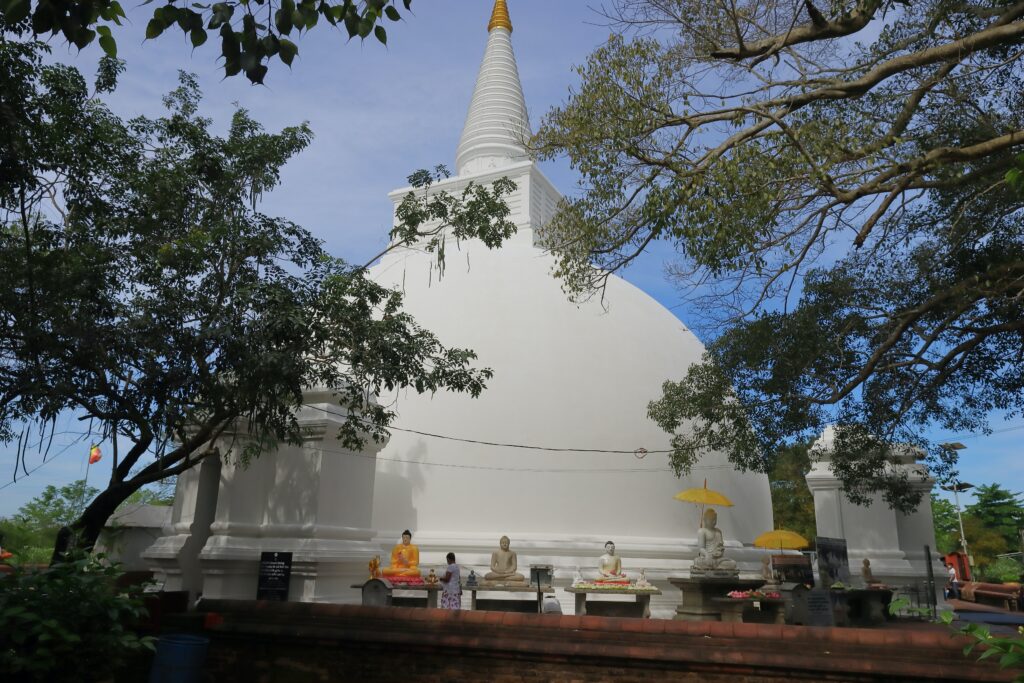
Polonnaruwa, the ancient capital of Sri Lanka, is a popular destination for tourists looking to explore the rich history and culture of the island. There are plenty of things to do in Polonnaruwa, from exploring ancient temples and monuments to enjoying the natural beauty of the area. Here are some of the top things to do in Polonnaruwa:
- Visit the Ancient City: Polonnaruwa is home to an impressive collection of ancient temples, monuments, and palaces, all of which are located within a short distance of each other. Visitors can explore the ruins of the Royal Palace, marvel at the impressive statues at Gal Vihara, and take in the stunning views of the Parakrama Samudraya.
- See the Rankoth Vehera: The Rankoth Vehera is one of the most impressive stupas in Sri Lanka and is a must-see destination for anyone visiting Polonnaruwa. The stupa stands at nearly 55 meters tall and is surrounded by a wall of intricately carved stone.
- Explore Kiri Vehera: Kiri Vehera is another important stupa in Polonnaruwa and is one of the best-preserved examples of ancient Sri Lankan architecture. Visitors can climb to the top of the stupa for stunning views of the surrounding area.
- Visit Polonnaruwa Vatadage: The Polonnaruwa Vatadage is an ancient circular relic house that was built to house a sacred object. The structure is surrounded by a wall of intricately carved stone and is an impressive example of ancient Sri Lankan architecture.
- Take a Walk through Nissanka Latha Mandapaya: The Nissanka Latha Mandapaya is an ancient temple located on the shores of the Parakrama Samudraya. The temple is known for its intricate stone carvings and is a must-see destination for anyone interested in ancient Sri Lankan art and architecture.
- Enjoy the Scenery at Parakrama Samudraya: The Parakrama Samudraya is a massive man-made reservoir that is surrounded by stunning natural beauty. Visitors can take a boat ride on the reservoir or simply enjoy a walk along its shores.
- Admire the Sandakada Pahana: The Sandakada Pahana is a beautiful stone carving that is located at the entrance to many ancient temples in Sri Lanka. The carving is believed to represent the cycle of life and is an impressive example of ancient Sri Lankan art.
Overall, Polonnaruwa is a destination that is sure to captivate anyone interested in history, culture, and natural beauty. With its impressive collection of ancient temples and monuments, stunning natural scenery, and warm hospitality, Polonnaruwa is a must-see destination for anyone visiting Sri Lanka.
Tips for Visiting Polonnaruwa
- Wear comfortable shoes and clothing that cover your shoulders and knees, as many of the sites are religious in nature.
- Bring plenty of water and sunscreen, as the sun can be intense during the day.
- Consider hiring a guide to take you around the different sites and provide insight into their history.
- Be respectful of the religious and cultural significance of the sites and avoid littering or causing damage.
Polonnaruwa is a fascinating destination that offers a unique glimpse into Sri Lanka’s rich history and culture. From the grandeur of King Parakramabahu’s reign to the intricate carvings of the Nissanka Latha Mandapaya, there’s something for everyone to explore and enjoy. So, pack your bags and head to Polonnaruwa for a journey back in time.
FAQ
What is Polonnaruwa known for?
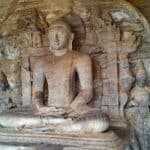
Polonnaruwa is known for its rich history and culture, including its impressive collection of ancient temples, monuments, and palaces.
How far is Polonnaruwa from Colombo?
Polonnaruwa is located approximately 220 kilometers east of Colombo and can be reached by car or public transportation.
What is the best time to visit Polonnaruwa?
The best time to visit Polonnaruwa is between November and February when the weather is dry and comfortable for exploring the ancient ruins.
Can I visit Polonnaruwa in one day?
Yes, it is possible to visit Polonnaruwa in one day, although it is recommended to spend at least two days in the area to fully explore the ancient ruins and natural beauty of the region.
Is there an entrance fee to visit Polonnaruwa?
Yes, there is an entrance fee to visit the ancient ruins of Polonnaruwa. The fee varies depending on your nationality and is typically around 25 USD for foreign visitors.
What should I wear when visiting Polonnaruwa?
It is recommended to wear comfortable clothing that covers your shoulders and knees when visiting Polonnaruwa out of respect for the religious sites. Sunscreen and a hat are also recommended as it can get quite hot during the day.
Are there any accommodations in Polonnaruwa?
Yes, there are plenty of accommodations in Polonnaruwa ranging from budget guesthouses to luxury hotels. It is recommended to book in advance during the high season.
